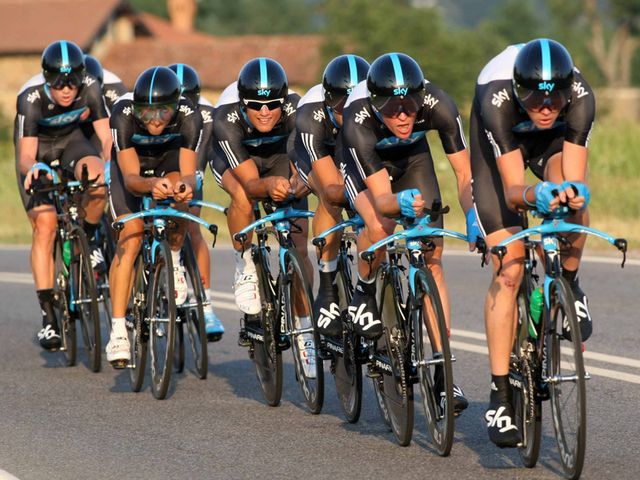
A Team Time Trial (TTT) is very similar to a standard Time Trial with similar rules. The first noticeable difference of course is that it is predominantly a team event, the race is ridden as a team, and the winner of the stage will be the team rather than an individual. Taken from Wikipedia:
The main principle behind a TTT is that a few riders can ride at the front of the formation slightly above their aerobic threshold while others draft behind these riders. The riders then rotate, allowing some riders to recover while drafting behind fresher teammates. A rider who is riding at the front is said to be taking a pull. The choice of formation is crucial to the performance of the team because it dictates how fast the riders can rotate. The two most popular formations are the single paceline and double paceline. In a single paceline, riders take longer pulls. Often, a double paceline is desirable since each rider takes shorter pulls, and therefore a higher pace is able to be maintained. This is why double pacelines are more often seen at the end of a TTT event when the teams are nearing the finish line.
There are of course other tactics within a TTT such as placement of strongest riders and TT specialists, length of each turn on the front, pace etc but the above covers it pretty well. Usually in a TTT the finish time is take when the fifth rider in each team crosses the line as this encourages a team to keep the minimum number together. Some teams work harder on their TTT skills than others, however time gaps are generally marginal and the riders looking to perform well in the overall of a stage race generally have pretty well equipped teams capable of putting in a decent TTT. Some of the smaller teams outside of the WorldTour who have been invited to the race may be a little slower. Here is the punchline though, if it is a team event and the riders that cross the finish line together get the same recorded time, how does this pose any real danger for the General Classification?...
Well, this is where it gets tactical because if a rider gets dropped from the group because they can't keep up the pace and crosses the finish alone, then the dropped rider will get his actual time, not that of the fifth rider. If say for instance the dropped rider happens to be the team leader or the best placed GC guy, then difficult decisions would have to be made as to whether to hang back and wait for them or whether the GC or Team Performance is more important and this can often lead to chaos as riders lose rhythm and concentration. Even if the team does wait for their leader and try to drag them to the finish, this in itself may only lead a much slower team time, in which case the time will still be lost in the GC as well.
Ivan Basso, Roman Kreuziger, Frank Schleck and Michele Scarponi will all need to bust a gut tomorrow to make sure they don't lose any ground. Taylor Phinney is a bit of a TT specialist but may well lose the pink jersey tomorrow depending on how he has recovered from stage three's crash and his swollen ankle. Looking at Michele Scarponi and Frank Schlecks poor performances in the opening time trial its them and their Lampre and Radioshack-Nissan teams who may well be under pressure come tomorrow. In a Grand Tour, every second counts...

No comments:
Post a Comment